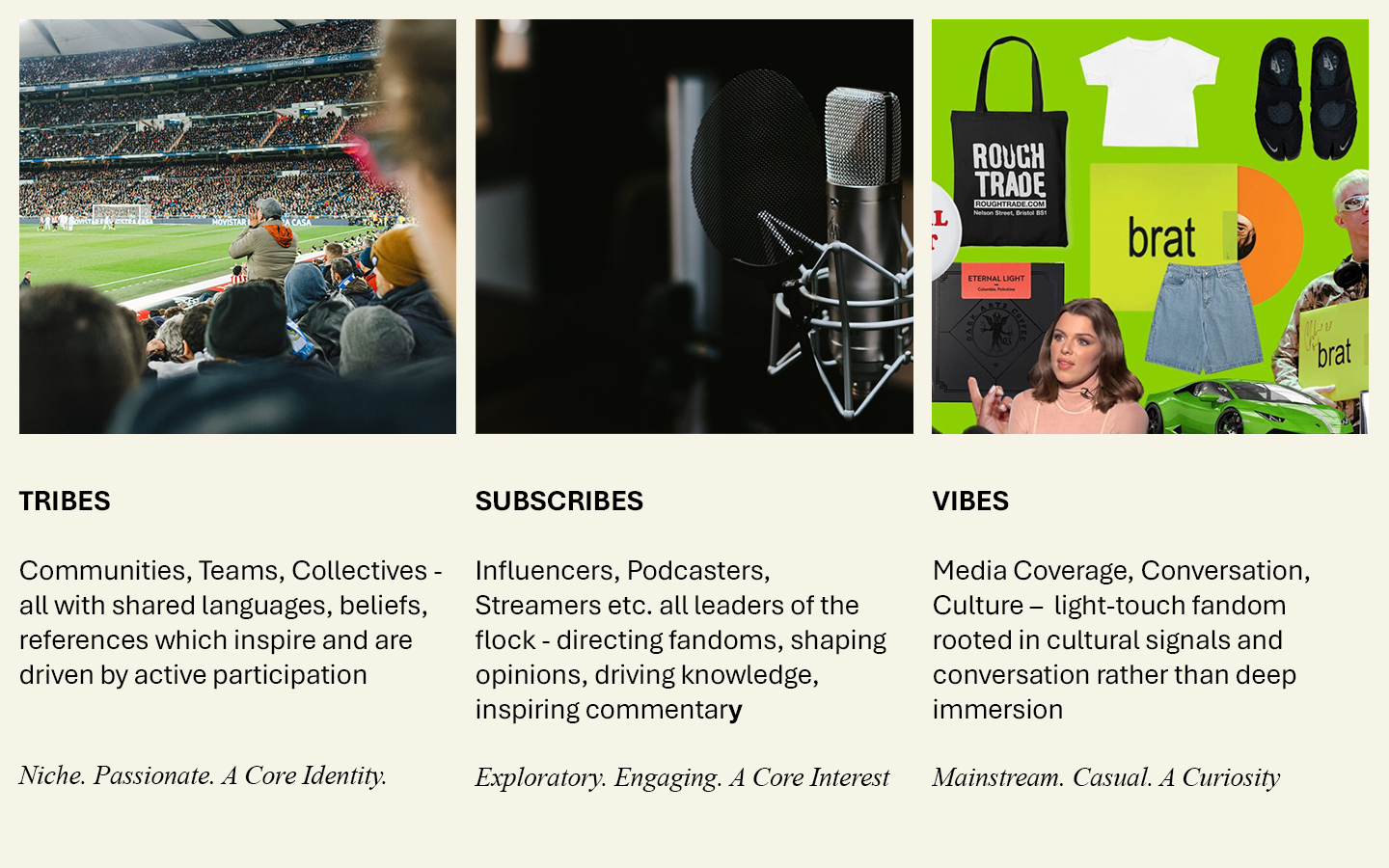I was rewatching TNT Sport’s coverage of the Champions League semi-final between Arsenal and PSG recently when something clicked. Jack Wilshere described Arsenal’s loss as “frustrating for us Arsenal fans.” Martin Keown repeatedly referred to the team as “we”, and Julien Laurens, TNT’s European football expert, was introduced by another presenter as the “a PSG super fan.”
In that moment, I realised they were broadcasting not so much as journalists, but as fans. As much as I was watching the football, I was also watching fandom as entertainment. As performance. Emotion, allegiance, rivalry – it was all part of the show. These weren’t pundits dissecting the game; they were inhabiting it. And more than anything, they were inviting the rest of us to do the same.

But this isn’t an article about football. It just so happens that football is helping illustrate a point I’d like to make.
Being a “fan” of something has changed.
Fandom used to be niche, and we more readily associated fandom with subcultures (Dungeons & Dragons, now multimillion dollar franchise), countercultures (punk) or – to the judgmental eye – as a sign of having no culture (see the distaste that Comicon and ‘nerd’ culture used to garner).
Now fandom is the culture. It’s on mainstream television, it’s online, it’s in events, it’s everywhere. It dictates and directs how we consume entertainment.
Where fandom was once a performance of self-expression, a statement of identity now it is the performance of entertainment.
A new MIDia report has found that gamers spend more time watching content about their favourite games (on Twitch, YouTube etc.), than actually playing them.[1] It’s a case of seeing other people’s fandom, sharing in it, but crucially being entertained by it.
But what does the age of fandom as entertainment really mean?
The Age of Fluid Fandom
Fandoms are not isolated: we live in the age of fluid fandom. We have access to more and more content than ever before, and our tastes and interests are increasingly driven by others. By friends, by families, by communities, by influencers, by podcasters, by algorithms.
A YouTube study shows that 85% of people identify as a “fan” of something, but something isn’t one thing.[2] It’s many. Fandom has gone from siloed, niche interests or events to a multichannel, multidiscipline, multipurpose behemoth.
Sky Sports, in a study commissioned on fandom of women’s sport, found that the biggest addressable market for women’s sport was UK sports fans who were interested in at least one men’s and women’s sport.[3] I.e. fans of multiple sports.
The nature of fandom has changed. Whereas before fandom was all about finding your tribe, cultivating a shared language, interest, behaviours, it’s now spread out over a variety of interests and channels.
So why should brands and businesses care?
Well, we’re seeing whole industries be uprooted by content about content – essentially harnessing fandom as a sales technique.
To pick one example, fragrance and skincare brands are scrambling to protect their margins against the phenomenon of duping – new-to-world brands essentially copying their formulations and promoting their much cheaper product via social media and word of mouth. There are more than 25,000 videos on TikTok under the combined hashtag #perfumedupe and #perfumedupes, where influencers rate imitation fragrances and tell viewers where to find them.[4]

What we’re seeing is that fandom has become the cultural conversation. The commentary to comment on.
And brands that understand that are the brands that will succeed.
Better Understanding Consumer Fandom
Fandom cuts across culture like nothing else: it’s cross-platform, cross-discipline and all cross-sections of society.
And it is consistently underpinned by a number of different emotional drivers.
Inspiration: An invitation to dream – following your heroes, inspiring you to emulate, create, engage further
Escapism: A way to relax and step out of the stress of your every day, immerse yourself in alternative worlds
Self-expression: An assertion of who you are – harnessing your passion and values to build your identity & image
Empowerment: An opportunity to exhibit your creativity, ingenuity and voice to show your worth, via content creation
Belonging: A chance to be part of a community greater than yourself and indulge in shared moments
It goes without saying, that tapping into these emotional drivers is the minimum a brand must do – creating content that can resonate. But it’s also worth stating that how we engage with fandom is diverse, wand we can apply three lenses to it… thinking of consumer fandoms as simply ‘tribes’ is no longer enough.

Looking at fandom in this way helps us understand how we can strategically access a wide range of consumers.
Subscribes are the area of fandom that brands are most obviously hotly competing for – gaining access to community leaders who shape opinions in an authentic and engaging way is basically influencer strategy 101.
But to ensure brands are authentically vibrant in culture, they need to craft strategies that can allow them to show up at all levels of the fandom conversation, not just targeting tribes or subscribes but considering activations, collaborations and approaches that fit across all fan typologies.
Connecting to all levels of fandom is how brands will truly win and gain cultural relevance and market share.
But in the age of fluid fandom, attention is transactional and therefore the real challenge for brands isn't just how to build a fanbase, but how to reward the consumer for giving your brand their attention.
This means abandoning the idea of brand as broadcaster, or even brand as storyteller. Instead, brands must operate as co-performers, co-creators, and props in the hands of the audience. It’s not just about having a platform – it’s about becoming usable, remixable, and reactive in real time.
Strategically, this demands a shift from brand consistency to brand improvisation. From campaigns that dictate what to believe to behaviours that stir emotion and inspire a response. Give consumers the freedom to respond to and even reshape and reimagine your brand to fit their world and values.
The most successful brands won’t be the ones with the strongest message, but the ones that are most playfully and meaningfully embedded in the performance of fandom. They’ll be the ones people use to signal who they are, where they stand, and what they love.
Because in this new paradigm, the brand is no longer the storyteller. The fan is.
References
- [1] https://www.gamesindustry.biz/new-report-claims-gamers-spend-more-time-watching-videos-about-gaming-than-playing-games?utm=syndication
- [2] https://adage.com/article/media/youtube-report-why-fans-are-biggest-force-pop-culture-right-now/2572121/
- 80% of UK sports fans are interested in at least one men’s and one women’s sport.
- https://www.ft.com/content/13839973-cff7-4c3e-ae29-377891a62b96

